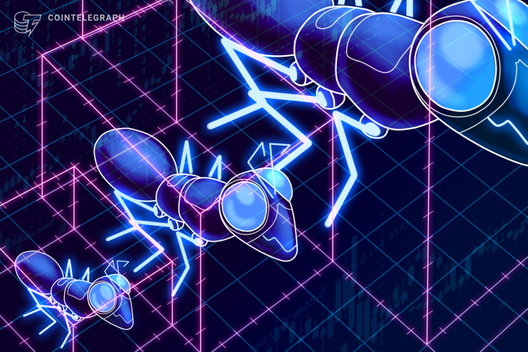What is extended reality (XR), explained
What is Bitcoin? How does blockchain work? How to mine cryptocurrency? We are glad to help you answer these questions with our quick guides in Explained section.
rn”,”seo_description”:”What is Bitcoin? How does blockchain work? How to mine cryptocurrency? We are glad to help you answer these questions with our quick guides in Explained section.”,”enabled”:1},”words_count”:829,”description”:”Extended reality refers to the combination of virtual reality, augmented reality and mixed reality technologies.”,”author”:{“id”:1470,”title”:”Onkar Singh”,”url”:”onkar-singh”,”twitter”:””,”google_plus”:””,”photo”:””,”gender”:”male”,”description”:”Onkar Singh is a blockchain enthusiast as he keeps a tab on the recent happenings pertaining to the crypto industry. He aims to provide quality content in blockchain and crypto domain. He is a financial content writer too and has worked on several financial projects related to the stock market news, fundamental research, and technical analysis for several websites.”,”facebook”:””,”email”:””,”linkedin”:””,”created_at”:”2022-01-28 14:30:55″,”updated_at”:”2022-04-05 22:44:33″,”deleted_at”:null,”innovation_circle_url”:null,”avatar”:”https://cointelegraph.com/assets/img/icons/author_male.jpg”,”hash”:”aHR0cHM6Ly9jb2ludGVsZWdyYXBoLmNvbS9hdXRob3JzL29ua2FyLXNpbmdo”,”relativeUrl”:”https://cointelegraph.com/authors/onkar-singh”,”user_id”:1470,”language_id”:1,”name”:”Onkar Singh”,”desc”:”Onkar Singh is a blockchain enthusiast as he keeps a tab on the recent happenings pertaining to the crypto industry. He aims to provide quality content in blockchain and crypto domain. He is a financial content writer too and has worked on several financial projects related to the stock market news, fundamental research, and technical analysis for several websites.”,”seo_title”:””,”seo_description”:””,”enabled”:1,”show_in_authors”:0,”show_in_experts”:0},”category_id”:65,”audio”:”https://s3.cointelegraph.com/audio/112805.d8405ae8-a2b3-4acc-904b-8b3299df1d5f.mp3″,”tags”:[{“name”:”Adoption”,”uri”:”/tags/adoption”,”super”:1,”page_title”:”Adoption News”},{“name”:”Virtual Reality”,”uri”:”/tags/virtual-reality”,”super”:0,”page_title”:”Virtual Reality News”}],”tag_title”:”Adoption”,”date”:”23 MINUTES AGO”,”badge”:{“title”:”Explained”,”label”:”default”},”qty”:3,”stats_pixel”:”“,”stats_pixel_url”:”https://zoa.cointelegraph.com/pixel?postId=112805®ionId=1″,”shares”:1,”infographic”:false,”sponsored”:false,”explained”:true,”press_release”:false,”show_referral”:false,”social_description”:”Experience a new reality with XR: a captivating fusion of virtual, augmented and mixed technologies. Immerse yourself and unlock limitless possibilities.”,”social_translators”:{“clipboard_popup_label”:”Link copied”,”socialWechatFooterError”:”WeChat error”,”socialWechatFooterText”:”WeChat share”,”socialWechatHeaderText”:”WeChat share”},”social_shares”:{“post_id”:112805,”post_url”:”https://cointelegraph.com/explained/what-is-extended-reality-xr-explained”,”post_titles”:{“normal”:”What is extended reality (XR), explained”,”twitter”:”What is extended reality (XR), explained”},”post_text”:{“normal”:”What is extended reality (XR), explained”,”twitter”:”What is extended reality (XR), explained https://cointelegraph.com/explained/what-is-extended-reality-xr-explained via @cointelegraph”},”accounts”:{“twitter”:”@cointelegraph”}},”socials”:{“facebook”:{“url”:”https://www.facebook.com/sharer/sharer.php?u=https%3A%2F%2Fcointelegraph.com%2Fexplained%2Fwhat-is-extended-reality-xr-explained”,”count”:null,”short”:”fb”,”fa”:”facebook”},”twitter”:{“url”:”https://twitter.com/intent/tweet?text=What+is+extended+reality+%28XR%29%2C+explained https%3A%2F%2Fcointelegraph.com%2Fexplained%2Fwhat-is-extended-reality-xr-explained via @cointelegraph”,”count”:null,”short”:”tw”,”fa”:”twitter”},”telegram”:{“url”:”https://telegram.me/share/url?url=https%3A%2F%2Fcointelegraph.com%2Fexplained%2Fwhat-is-extended-reality-xr-explained &text=What+is+extended+reality+%28XR%29%2C+explained”,”count”:null,”short”:”tg”,”fa”:”paper-plane”},”whatsapp”:{“url”:”https://api.whatsapp.com/send?text=What+is+extended+reality+%28XR%29%2C+explained&href=https%3A%2F%2Fcointelegraph.com%2Fexplained%2Fwhat-is-extended-reality-xr-explained”,”count”:null,”short”:”wu”,”fa”:”whatsapp”},”gplus”:{“url”:”https://plus.google.com/share?url=https%3A%2F%2Fcointelegraph.com%2Fexplained%2Fwhat-is-extended-reality-xr-explained”,”count”:null,”short”:”gplus”,”fa”:”google-plus”},”reddit”:{“url”:”https://www.reddit.com/submit?url=https%3A%2F%2Fcointelegraph.com%2Fexplained%2Fwhat-is-extended-reality-xr-explained&title=What+is+extended+reality+%28XR%29%2C+explained”,”count”:null,”short”:”reddit”,”fa”:”reddit-alien”},”linkedin”:{“url”:”https://www.linkedin.com/shareArticle?mini=true&url=https%3A%2F%2Fcointelegraph.com%2Fexplained%2Fwhat-is-extended-reality-xr-explained&title=What+is+extended+reality+%28XR%29%2C+explained”,”count”:null,”short”:”li”,”fa”:”linkedin”}},”hide_disclaimer”:false,”elink”:”https://cointelegraph.com”,”etitle”:”Cointelegraph”,”elogo_x2″:”https://images.cointelegraph.com/cdn-cgi/image/format=auto,onerror=redirect,quality=90,width=528/https://s3.cointelegraph.com/storage/uploads/view/ab03a2a2ce9a21dc1f0961d91731c8ba.png”,”elogo_x1″:”https://images.cointelegraph.com/cdn-cgi/image/format=auto,onerror=redirect,quality=90,width=260/https://s3.cointelegraph.com/storage/uploads/view/ab03a2a2ce9a21dc1f0961d91731c8ba.png”,”elogo_svg”:false,”content”:[{“id”:4252,”post_id”:112805,”title”:”An overview of extended reality”,”content”:”
Extended reality (XR) refers to technologies combining real and virtual settings to produce engaging and immersive experiences.
nn
Virtual reality (VR), augmented reality (AR) and mixed reality (MR) are just a few of the technologies that fall under the umbrella term of XR. VR is a technology that immerses people entirely in a digital simulation, cutting them off from their surroundings.
nn
A virtual environment is often displayed through screens or lenses while users wear a VR headset recording their head movements. Users can explore virtual surroundings, interact with objects and participate in various activities through VR experiences.
nn
AR overlays digital information onto the real world, enhancing the user’s perception and interaction with their physical surroundings. Usually, AR is used with smartphones, tablets or AR glasses. Users can simultaneously engage with both virtual and physical aspects thanks to its ability to project virtual objects, text or images into the actual world. Numerous industries, including gaming, education, navigation and industrial training, use augmented reality applications.
nn
MR is a hybrid form of reality integrating components of VR and AR. Users of MR systems can engage with virtual items while staying conscious of and engaging with their real-world surroundings. Wearing specialized headsets or glasses is a common requirement for MR, which enables the appearance of virtual objects and their interaction with the real world by tracking the user’s position and surroundings.
nn

nn
XR technologies are utilized for various purposes, including recreation, gaming, education, training simulations, online meetings and collaboration, architectural and industrial design, healthcare, and more. By creating immersive and compelling experiences beyond conventional interfaces, XR has the potential to completely transform how we engage with information, communicate, learn and experience virtual worlds.
nnnn”,”created_at”:”2023-07-19 12:49:19″,”updated_at”:”2023-07-19 13:20:20″,”sort”:1,”translations”:{“id”:4245,”explained_post_id”:4252,”title_en”:”An overview of extended reality”,”content_en”:”
Extended reality (XR) refers to technologies combining real and virtual settings to produce engaging and immersive experiences.
nn
Virtual reality (VR), augmented reality (AR) and mixed reality (MR) are just a few of the technologies that fall under the umbrella term of XR. VR is a technology that immerses people entirely in a digital simulation, cutting them off from their surroundings.
nn
A virtual environment is often displayed through screens or lenses while users wear a VR headset recording their head movements. Users can explore virtual surroundings, interact with objects and participate in various activities through VR experiences.
nn
AR overlays digital information onto the real world, enhancing the user’s perception and interaction with their physical surroundings. Usually, AR is used with smartphones, tablets or AR glasses. Users can simultaneously engage with both virtual and physical aspects thanks to its ability to project virtual objects, text or images into the actual world. Numerous industries, including gaming, education, navigation and industrial training, use augmented reality applications.
nn
MR is a hybrid form of reality integrating components of VR and AR. Users of MR systems can engage with virtual items while staying conscious of and engaging with their real-world surroundings. Wearing specialized headsets or glasses is a common requirement for MR, which enables the appearance of virtual objects and their interaction with the real world by tracking the user’s position and surroundings.
nn

nn
XR technologies are utilized for various purposes, including recreation, gaming, education, training simulations, online meetings and collaboration, architectural and industrial design, healthcare, and more. By creating immersive and compelling experiences beyond conventional interfaces, XR has the potential to completely transform how we engage with information, communicate, learn and experience virtual worlds.
nnnn”,”title_es”:””,”content_es”:”nn”,”title_cn”:””,”content_cn”:”nn”,”title_de”:””,”content_de”:”nn”,”title_fr”:””,”content_fr”:”nn”,”title_it”:””,”content_it”:”nn”,”title_ar”:””,”content_ar”:”nn”,”title_br”:””,”content_br”:”nn”,”title_jp”:””,”content_jp”:”nn”,”created_at”:”2023-07-19 12:49:19″,”updated_at”:”2023-07-19 13:20:20″,”title_kr”:””,”content_kr”:”nn”,”title_tr”:””,”content_tr”:”nn”}},{“id”:4253,”post_id”:112805,”title”:”How extended reality works”,”content”:”
XR works by constructing immersive experiences that combine real-world and virtual components. The specific workings of XR depend on the technology being used, whether it’s VR, AR or MR.
nn
Here’s how these technologies work:
nn
Virtual reality
nn
VR technology produces immersive experiences by replacing the user’s surroundings with virtual ones. Users put on a VR headset that has sensors integrated into it to track their head movements. The headset shows stereo 3D images that give the user a sensation of depth and immersion.
nn
The realistic experience is further improved by the spatial audio provided by built-in headphones or speakers. Users use handheld controllers to interact with the virtual environment, and the system tracks these controllers to map the users’ positions and motions.
nn
Augmented reality
nn
Incorporating virtual features in real-world environments is known as AR, which improves a user’s perception of and engagement with their surroundings. Smartphones, tablets and special AR glasses can deliver AR experiences. The device’s camera records the surroundings, while gyroscopes and accelerometers monitor its orientation and location.
nn
AR software analyzes the camera feed, which identifies characteristics and objects in the real environment. The user’s vision is rendered and superimposed with virtual objects, text, or images on the device’s screen or through AR glasses. Touchscreens, gestures and voice commands can all be used by users to interface with the virtual components.
nn
Mixed reality
nn
Users can interact with virtual items while still being aware of and engaging with their physical environment thanks to mixed reality, which includes elements of both VR and AR. Like AR and VR systems, MR headsets are furnished with cameras, sensors and displays.
nn
By using the cameras and sensors, the MR system maps the physical area to digitally represent the actual surroundings. After that, virtual objects are rendered and fixed in place in the user’s field of view, allowing for natural interaction and occlusion with the surrounding environment. While still viewing and engaging with the real environment, users can modify and interact with virtual items.
nnnn”,”created_at”:”2023-07-19 12:49:39″,”updated_at”:”2023-07-19 13:20:20″,”sort”:2,”translations”:{“id”:4246,”explained_post_id”:4253,”title_en”:”How extended reality works”,”content_en”:”
XR works by constructing immersive experiences that combine real-world and virtual components. The specific workings of XR depend on the technology being used, whether it’s VR, AR or MR.
nn
Here’s how these technologies work:
nn
Virtual reality
nn
VR technology produces immersive experiences by replacing the user’s surroundings with virtual ones. Users put on a VR headset that has sensors integrated into it to track their head movements. The headset shows stereo 3D images that give the user a sensation of depth and immersion.
nn
The realistic experience is further improved by the spatial audio provided by built-in headphones or speakers. Users use handheld controllers to interact with the virtual environment, and the system tracks these controllers to map the users’ positions and motions.
nn
Augmented reality
nn
Incorporating virtual features in real-world environments is known as AR, which improves a user’s perception of and engagement with their surroundings. Smartphones, tablets and special AR glasses can deliver AR experiences. The device’s camera records the surroundings, while gyroscopes and accelerometers monitor its orientation and location.
nn
AR software analyzes the camera feed, which identifies characteristics and objects in the real environment. The user’s vision is rendered and superimposed with virtual objects, text, or images on the device’s screen or through AR glasses. Touchscreens, gestures and voice commands can all be used by users to interface with the virtual components.
nn
Mixed reality
nn
Users can interact with virtual items while still being aware of and engaging with their physical environment thanks to mixed reality, which includes elements of both VR and AR. Like AR and VR systems, MR headsets are furnished with cameras, sensors and displays.
nn
By using the cameras and sensors, the MR system maps the physical area to digitally represent the actual surroundings. After that, virtual objects are rendered and fixed in place in the user’s field of view, allowing for natural interaction and occlusion with the surrounding environment. While still viewing and engaging with the real environment, users can modify and interact with virtual items.
nnnn”,”title_es”:””,”content_es”:”nn”,”title_cn”:””,”content_cn”:”nn”,”title_de”:””,”content_de”:”nn”,”title_fr”:””,”content_fr”:”nn”,”title_it”:””,”content_it”:”nn”,”title_ar”:””,”content_ar”:”nn”,”title_br”:””,”content_br”:”nn”,”title_jp”:””,”content_jp”:”nn”,”created_at”:”2023-07-19 12:49:39″,”updated_at”:”2023-07-19 13:20:20″,”title_kr”:””,”content_kr”:”nn”,”title_tr”:””,”content_tr”:”nn”}},{“id”:4254,”post_id”:112805,”title”:”XR vs. AR vs. VR vs. MR: What’s the difference?”,”content”:”
XR, AR, VR, and MR are different technologies that alter our perception of reality, with XR being the umbrella term encompassing AR, VR and MR.
nn
The below table summarizes the differences between XR, VR, AR and MR:
nn

nnnn”,”created_at”:”2023-07-19 12:50:10″,”updated_at”:”2023-07-19 13:20:20″,”sort”:3,”translations”:{“id”:4247,”explained_post_id”:4254,”title_en”:”XR vs. AR vs. VR vs. MR: What’s the difference?”,”content_en”:”
XR, AR, VR, and MR are different technologies that alter our perception of reality, with XR being the umbrella term encompassing AR, VR and MR.
nn
The below table summarizes the differences between XR, VR, AR and MR:
nn

nnnn”,”title_es”:””,”content_es”:”nn”,”title_cn”:””,”content_cn”:”nn”,”title_de”:””,”content_de”:”nn”,”title_fr”:””,”content_fr”:”nn”,”title_it”:””,”content_it”:”nn”,”title_ar”:””,”content_ar”:”nn”,”title_br”:””,”content_br”:”nn”,”title_jp”:””,”content_jp”:”nn”,”created_at”:”2023-07-19 12:50:10″,”updated_at”:”2023-07-19 13:20:20″,”title_kr”:””,”content_kr”:”nn”,”title_tr”:””,”content_tr”:”nn”}},{“id”:4255,”post_id”:112805,”title”:”Benefits of extended reality”,”content”:”
XR offers benefits such as enhanced immersion, improved learning, efficient visualization, remote collaboration and increased accessibility.
nn
XR offers improved immersion, enabling users to lose themselves entirely in virtual settings. This immersive environment creates more realistic training simulations, interesting educational materials and engaging entertainment experiences.
nn
By facilitating direct interaction and hands-on learning, XR improves learning and memory. Users can interact with virtual objects, visualize difficult concepts, and participate in interactive scenarios, improving information retention and comprehension.
nn
XR has important applications in manufacturing, architecture and healthcare industries, enabling collaborative design reviews, realistic visualizations and virtual prototyping. This results in better decision-making, greater effectiveness and lower costs.
nn
Additionally, by facilitating virtual meetings and sharing virtual spaces regardless of physical locations, XR supports distant collaboration. This boosts output, reduces travel costs and encourages international cooperation.
nn
Moreover, by generating inclusive experiences for those with disabilities, XR has the potential to increase accessibility. It can offer various communication methods, flexible user interfaces and sensory stimulation.
nnnn”,”created_at”:”2023-07-19 12:50:29″,”updated_at”:”2023-07-19 13:20:20″,”sort”:4,”translations”:{“id”:4248,”explained_post_id”:4255,”title_en”:”Benefits of extended reality”,”content_en”:”
XR offers benefits such as enhanced immersion, improved learning, efficient visualization, remote collaboration and increased accessibility.
nn
XR offers improved immersion, enabling users to lose themselves entirely in virtual settings. This immersive environment creates more realistic training simulations, interesting educational materials and engaging entertainment experiences.
nn
By facilitating direct interaction and hands-on learning, XR improves learning and memory. Users can interact with virtual objects, visualize difficult concepts, and participate in interactive scenarios, improving information retention and comprehension.
nn
XR has important applications in manufacturing, architecture and healthcare industries, enabling collaborative design reviews, realistic visualizations and virtual prototyping. This results in better decision-making, greater effectiveness and lower costs.
nn
Additionally, by facilitating virtual meetings and sharing virtual spaces regardless of physical locations, XR supports distant collaboration. This boosts output, reduces travel costs and encourages international cooperation.
nn
Moreover, by generating inclusive experiences for those with disabilities, XR has the potential to increase accessibility. It can offer various communication methods, flexible user interfaces and sensory stimulation.
nnnn”,”title_es”:””,”content_es”:”nn”,”title_cn”:””,”content_cn”:”nn”,”title_de”:””,”content_de”:”nn”,”title_fr”:””,”content_fr”:”nn”,”title_it”:””,”content_it”:”nn”,”title_ar”:””,”content_ar”:”nn”,”title_br”:””,”content_br”:”nn”,”title_jp”:””,”content_jp”:”nn”,”created_at”:”2023-07-19 12:50:29″,”updated_at”:”2023-07-19 13:20:20″,”title_kr”:””,”content_kr”:”nn”,”title_tr”:””,”content_tr”:”nn”}},{“id”:4256,”post_id”:112805,”title”:”Challenges associated with extended reality”,”content”:”
Extended reality faces challenges such as technical limitations, user comfort, content development, interoperability and privacy considerations.
nn
The technical constraints related to providing high-quality XR experiences are one major challenge. Powerful hardware and software requirements for XR systems make them expensive and may prevent their general adoption, especially for people or organizations with low funding.
nn
Additionally, certain users may have pain and sensory problems from XR’s immersive nature, such as motion sickness, eye strain or confusion. For broader acceptance and adoption, it is essential to guarantee user comfort and safety during prolonged XR sessions.
nn
The requirement for content development and creation presents another difficulty. Specialized material catered to the particular technology and platform is needed for XR experiences. It can take a lot of time and resources to create high-quality XR content, necessitating knowledge of 3D modeling, animation and interactive design. It’s still difficult to find diverse and interesting XR content for use in many fields and contexts.
nn
Standardization and interoperability present additional difficulties. XR includes several platforms, technologies and devices, each with unique needs for interoperability. Cross-platform experiences and flawless interoperability between various XR systems can be difficult to enable, which hinders integration and broad adoption.
nn
In XR, privacy and ethical issues are also significant challenges. Data privacy, security, and user consent concerns must be addressed since XR experiences entail collecting and analyzing user data. Using XR in delicate contexts like healthcare, education, or the workplace also raises ethical questions that call for careful consideration of data ownership, consent and responsible use.
nnnn”,”created_at”:”2023-07-19 12:50:43″,”updated_at”:”2023-07-19 13:20:20″,”sort”:5,”translations”:{“id”:4249,”explained_post_id”:4256,”title_en”:”Challenges associated with extended reality”,”content_en”:”
Extended reality faces challenges such as technical limitations, user comfort, content development, interoperability and privacy considerations.
nn
The technical constraints related to providing high-quality XR experiences are one major challenge. Powerful hardware and software requirements for XR systems make them expensive and may prevent their general adoption, especially for people or organizations with low funding.
nn
Additionally, certain users may have pain and sensory problems from XR’s immersive nature, such as motion sickness, eye strain or confusion. For broader acceptance and adoption, it is essential to guarantee user comfort and safety during prolonged XR sessions.
nn
The requirement for content development and creation presents another difficulty. Specialized material catered to the particular technology and platform is needed for XR experiences. It can take a lot of time and resources to create high-quality XR content, necessitating knowledge of 3D modeling, animation and interactive design. It’s still difficult to find diverse and interesting XR content for use in many fields and contexts.
nn
Standardization and interoperability present additional difficulties. XR includes several platforms, technologies and devices, each with unique needs for interoperability. Cross-platform experiences and flawless interoperability between various XR systems can be difficult to enable, which hinders integration and broad adoption.
nn
In XR, privacy and ethical issues are also significant challenges. Data privacy, security, and user consent concerns must be addressed since XR experiences entail collecting and analyzing user data. Using XR in delicate contexts like healthcare, education, or the workplace also raises ethical questions that call for careful consideration of data ownership, consent and responsible use.
nnnn”,”title_es”:””,”content_es”:”nn”,”title_cn”:””,”content_cn”:”nn”,”title_de”:””,”content_de”:”nn”,”title_fr”:””,”content_fr”:”nn”,”title_it”:””,”content_it”:”nn”,”title_ar”:””,”content_ar”:”nn”,”title_br”:””,”content_br”:”nn”,”title_jp”:””,”content_jp”:”nn”,”created_at”:”2023-07-19 12:50:43″,”updated_at”:”2023-07-19 13:20:20″,”title_kr”:””,”content_kr”:”nn”,”title_tr”:””,”content_tr”:”nn”}},{“id”:4257,”post_id”:112805,”title”:”Is the metaverse a type of extended reality?”,”content”:”
XR and the idea of the metaverse are closely connected, albeit not necessarily the same thing.
nn
XR includes the blending of digital and physical settings to produce engaging experiences. The metaverse, on the other hand, is a virtual universe or interconnected network of virtual and augmented realities. It transcends the limitations of XR technology and spans a vast digital space where users can engage with a range of virtual communities and experiences.
nn
User-generated content, social interactions, persistent online places and economic mechanisms define the metaverse. It seeks to deliver an experience that transcends particular XR technology and is shared, immersive and collaborative.
nn
The metaverse concept goes beyond XR and encompasses a broader vision of a fully realized virtual universe with its own economy, social dynamics, and opportunities for user participation and creativity. While XR contributes to realizing the metaverse by providing the foundational technologies for virtual and augmented experiences, the metaverse concept extends beyond XR.
nnnn”,”created_at”:”2023-07-19 12:50:59″,”updated_at”:”2023-07-19 13:20:20″,”sort”:6,”translations”:{“id”:4250,”explained_post_id”:4257,”title_en”:”Is the metaverse a type of extended reality?”,”content_en”:”
XR and the idea of the metaverse are closely connected, albeit not necessarily the same thing.
nn
XR includes the blending of digital and physical settings to produce engaging experiences. The metaverse, on the other hand, is a virtual universe or interconnected network of virtual and augmented realities. It transcends the limitations of XR technology and spans a vast digital space where users can engage with a range of virtual communities and experiences.
nn
User-generated content, social interactions, persistent online places and economic mechanisms define the metaverse. It seeks to deliver an experience that transcends particular XR technology and is shared, immersive and collaborative.
nn
The metaverse concept goes beyond XR and encompasses a broader vision of a fully realized virtual universe with its own economy, social dynamics, and opportunities for user participation and creativity. While XR contributes to realizing the metaverse by providing the foundational technologies for virtual and augmented experiences, the metaverse concept extends beyond XR.
nnnn”,”title_es”:””,”content_es”:”nn”,”title_cn”:””,”content_cn”:”nn”,”title_de”:””,”content_de”:”nn”,”title_fr”:””,”content_fr”:”nn”,”title_it”:””,”content_it”:”nn”,”title_ar”:””,”content_ar”:”nn”,”title_br”:””,”content_br”:”nn”,”title_jp”:””,”content_jp”:”nn”,”created_at”:”2023-07-19 12:50:59″,”updated_at”:”2023-07-19 13:20:20″,”title_kr”:””,”content_kr”:”nn”,”title_tr”:””,”content_tr”:”nn”}}],”is_partner_material”:false,”commentsSection”:{“schemaEntityUrl”:”//cointelegraph.com/explained/what-is-extended-reality-xr-explained”,”list”:[],”amount”:0,”i18n”:{“addComment”:”Add a comment…”,”amountOnePostfix”:”Comment”,”amountPostfix”:”Comments”,”cancel”:”Cancel”,”delete”:”Delete”,”edit”:”Edit”,”errorBig”:”Comment text cannot be longer than 2000 characters”,”errorDuplicate”:”Duplicate comment”,”errorSmall”:”Comment text must be at least 2 characters long”,”hideButton”:”Hide comments”,”noComments”:” “,”commentOnModeration”:”Comment on moderation”,”postComment”:”Post”,”reply”:”Reply”,”showAllComments”:”Show All Comments”,”showButtonPostfix”:”comments”,”showButtonPrefix”:”Show”,”signIn”:”Sign in”,”update”:”Update comment”,”commentWasDeleted”:”This comment has been deleted”}},”related”:[{“id”:108874,”retina”:”https://images.cointelegraph.com/cdn-cgi/image/format=auto,onerror=redirect,quality=90,width=1480/https://s3.cointelegraph.com/storage/uploads/view/89498bdae48eb1bb83c43c07e838e8ad.jpg”,”img”:”https://images.cointelegraph.com/cdn-cgi/image/format=auto,onerror=redirect,quality=90,width=740/https://s3.cointelegraph.com/storage/uploads/view/89498bdae48eb1bb83c43c07e838e8ad.jpg”,”thumb”:”https://images.cointelegraph.com/cdn-cgi/image/format=auto,onerror=redirect,quality=90,width=370/https://s3.cointelegraph.com/storage/uploads/view/89498bdae48eb1bb83c43c07e838e8ad.jpg”,”thumb370″:”https://images.cointelegraph.com/cdn-cgi/image/format=auto,onerror=redirect,quality=90,width=370/https://s3.cointelegraph.com/storage/uploads/view/89498bdae48eb1bb83c43c07e838e8ad.jpg”,”amp_thumb”:”https://images.cointelegraph.com/cdn-cgi/image/format=auto,onerror=redirect,quality=90,width=150/https://s3.cointelegraph.com/storage/uploads/view/89498bdae48eb1bb83c43c07e838e8ad.jpg”,”thumb150″:”https://images.cointelegraph.com/cdn-cgi/image/format=auto,onerror=redirect,quality=90,width=150/https://s3.cointelegraph.com/storage/uploads/view/89498bdae48eb1bb83c43c07e838e8ad.jpg”,”url”:”https://cointelegraph.com/explained/who-invented-nfts-a-brief-history-of-nonfungible-tokens”,”title”:”Who invented NFTs?: A brief history of nonfungible tokens”,”lead”:”Ever wondered who invented nonfungible tokens — aka NFTs? The timeline includes colored coins, quantum, CryptoPunks and a lot more.”,”leadfull”:””,”category_id”:65,”category_url”:”https://cointelegraph.com/explained”,”category_title”:”Explained”,”author_url”:”https://cointelegraph.com/authors/dilip-kumar-patairya”,”author_hash”:”aHR0cHM6Ly9jb2ludGVsZWdyYXBoLmNvbS9hdXRob3JzL2RpbGlwLWt1bWFyLXBhdGFpcnlh”,”author_title”:”Dilip Kumar Patairya”,”author_img”:”https://images.cointelegraph.com/cdn-cgi/image/format=auto,onerror=redirect,quality=90,width=32/https://s3.cointelegraph.com/storage/uploads/view/1cfc5d74c7b02ce3bfa5923936e90adb.jpg”,”date”:”MAY 20, 2023″,”flash_date”:”MAY 20, 2023″,”sponsored”:false,”press_release”:false,”sponsored_label”:”Sponsored”,”explained”:true,”badge”:{“title”:”Explained”,”label”:”default”},”published”:{“date”:”2023-05-20 15:35:00.000000″,”timezone_type”:3,”timezone”:”Europe/London”},”stat_uniqs”:985,”rss_date”:”Sat, 20 May 2023 15:35:00 +0100″,”publishedW3″:”2023-05-20T15:35:00+01:00″,”show_referral”:false,”isMagazine”:false},{“id”:110985,”retina”:”https://images.cointelegraph.com/cdn-cgi/image/format=auto,onerror=redirect,quality=90,width=1480/https://s3.cointelegraph.com/uploads/2023-06/e5d90b2c-67e8-4213-bf51-029d6aa6a06b.jpg”,”img”:”https://images.cointelegraph.com/cdn-cgi/image/format=auto,onerror=redirect,quality=90,width=740/https://s3.cointelegraph.com/uploads/2023-06/e5d90b2c-67e8-4213-bf51-029d6aa6a06b.jpg”,”thumb”:”https://images.cointelegraph.com/cdn-cgi/image/format=auto,onerror=redirect,quality=90,width=370/https://s3.cointelegraph.com/uploads/2023-06/e5d90b2c-67e8-4213-bf51-029d6aa6a06b.jpg”,”thumb370″:”https://images.cointelegraph.com/cdn-cgi/image/format=auto,onerror=redirect,quality=90,width=370/https://s3.cointelegraph.com/uploads/2023-06/e5d90b2c-67e8-4213-bf51-029d6aa6a06b.jpg”,”amp_thumb”:”https://images.cointelegraph.com/cdn-cgi/image/format=auto,onerror=redirect,quality=90,width=150/https://s3.cointelegraph.com/uploads/2023-06/e5d90b2c-67e8-4213-bf51-029d6aa6a06b.jpg”,”thumb150″:”https://images.cointelegraph.com/cdn-cgi/image/format=auto,onerror=redirect,quality=90,width=150/https://s3.cointelegraph.com/uploads/2023-06/e5d90b2c-67e8-4213-bf51-029d6aa6a06b.jpg”,”url”:”https://cointelegraph.com/news/nifty-news-queen-hsbc-hint-nfts-yuga-teases-game”,”title”:”Nifty News: Queen, HSBC filings hint at NFTs, Yuga teases robot game and more”,”lead”:”The rock band Queen and big bank HSBC eye up the metaverse while Yuga Labs launched the next iteration of its NFT gaming saga.”,”leadfull”:””,”category_id”:2,”category_url”:”https://cointelegraph.com/category/latest-news”,”category_title”:”Latest News”,”author_url”:”https://cointelegraph.com/authors/tom-mitchelhill”,”author_hash”:”aHR0cHM6Ly9jb2ludGVsZWdyYXBoLmNvbS9hdXRob3JzL3RvbS1taXRjaGVsaGlsbA==”,”author_title”:”Tom Mitchelhill “,”author_img”:”https://images.cointelegraph.com/cdn-cgi/image/format=auto,onerror=redirect,quality=90,width=32/https://s3.cointelegraph.com/storage/uploads/view/fc86287cdea2a9b161bd7e08acf215fc.jpg”,”date”:”JUN 21, 2023″,”flash_date”:”JUN 21, 2023″,”sponsored”:false,”press_release”:false,”sponsored_label”:”Sponsored”,”explained”:false,”badge”:{“title”:”News”,”label”:”default”},”published”:{“date”:”2023-06-21 03:06:14.000000″,”timezone_type”:3,”timezone”:”Europe/London”},”stat_uniqs”:3376,”rss_date”:”Wed, 21 Jun 2023 03:06:14 +0100″,”publishedW3″:”2023-06-21T03:06:14+01:00″,”show_referral”:true,”isMagazine”:false},{“id”:112308,”retina”:”https://images.cointelegraph.com/cdn-cgi/image/format=auto,onerror=redirect,quality=90,width=1480/https://s3.cointelegraph.com/uploads/2023-07/aad13d64-b8a7-479d-ac8a-dab2c873faab.jpg”,”img”:”https://images.cointelegraph.com/cdn-cgi/image/format=auto,onerror=redirect,quality=90,width=740/https://s3.cointelegraph.com/uploads/2023-07/aad13d64-b8a7-479d-ac8a-dab2c873faab.jpg”,”thumb”:”https://images.cointelegraph.com/cdn-cgi/image/format=auto,onerror=redirect,quality=90,width=370/https://s3.cointelegraph.com/uploads/2023-07/aad13d64-b8a7-479d-ac8a-dab2c873faab.jpg”,”thumb370″:”https://images.cointelegraph.com/cdn-cgi/image/format=auto,onerror=redirect,quality=90,width=370/https://s3.cointelegraph.com/uploads/2023-07/aad13d64-b8a7-479d-ac8a-dab2c873faab.jpg”,”amp_thumb”:”https://images.cointelegraph.com/cdn-cgi/image/format=auto,onerror=redirect,quality=90,width=150/https://s3.cointelegraph.com/uploads/2023-07/aad13d64-b8a7-479d-ac8a-dab2c873faab.jpg”,”thumb150″:”https://images.cointelegraph.com/cdn-cgi/image/format=auto,onerror=redirect,quality=90,width=150/https://s3.cointelegraph.com/uploads/2023-07/aad13d64-b8a7-479d-ac8a-dab2c873faab.jpg”,”url”:”https://cointelegraph.com/news/extended-reality-to-create-thousands-of-jobs-by-2025-eu-commission”,”title”:”EU Commission pushing for world leadership in Web4 and metaverse, lays out strategy”,”lead”:”The European Commission has laid out its plans for becoming a “world leader” in Web4 and the metaverse. “,”leadfull”:””,”category_id”:2,”category_url”:”https://cointelegraph.com/category/latest-news”,”category_title”:”Latest News”,”author_url”:”https://cointelegraph.com/authors/felix-ng”,”author_hash”:”aHR0cHM6Ly9jb2ludGVsZWdyYXBoLmNvbS9hdXRob3JzL2ZlbGl4LW5n”,”author_title”:” Felix Ng “,”author_img”:”https://images.cointelegraph.com/cdn-cgi/image/format=auto,onerror=redirect,quality=90,width=32/https://s3.cointelegraph.com/storage/uploads/view/8013d084e7c0d524369a4fff0f41626e.jpg”,”date”:”JUL 12, 2023″,”flash_date”:”JUL 12, 2023″,”sponsored”:false,”press_release”:false,”sponsored_label”:”Sponsored”,”explained”:false,”badge”:{“title”:”News”,”label”:”default”},”published”:{“date”:”2023-07-12 03:56:54.000000″,”timezone_type”:3,”timezone”:”Europe/London”},”stat_uniqs”:2793,”rss_date”:”Wed, 12 Jul 2023 03:56:54 +0100″,”publishedW3″:”2023-07-12T03:56:54+01:00″,”show_referral”:true,”isMagazine”:false},{“id”:112772,”retina”:”https://images.cointelegraph.com/cdn-cgi/image/format=auto,onerror=redirect,quality=90,width=1480/https://s3.cointelegraph.com/uploads/2023-07/fa736a52-4c8d-4f40-8f64-9d33ffc26ea2.jpg”,”img”:”https://images.cointelegraph.com/cdn-cgi/image/format=auto,onerror=redirect,quality=90,width=740/https://s3.cointelegraph.com/uploads/2023-07/fa736a52-4c8d-4f40-8f64-9d33ffc26ea2.jpg”,”thumb”:”https://images.cointelegraph.com/cdn-cgi/image/format=auto,onerror=redirect,quality=90,width=370/https://s3.cointelegraph.com/uploads/2023-07/fa736a52-4c8d-4f40-8f64-9d33ffc26ea2.jpg”,”thumb370″:”https://images.cointelegraph.com/cdn-cgi/image/format=auto,onerror=redirect,quality=90,width=370/https://s3.cointelegraph.com/uploads/2023-07/fa736a52-4c8d-4f40-8f64-9d33ffc26ea2.jpg”,”amp_thumb”:”https://images.cointelegraph.com/cdn-cgi/image/format=auto,onerror=redirect,quality=90,width=150/https://s3.cointelegraph.com/uploads/2023-07/fa736a52-4c8d-4f40-8f64-9d33ffc26ea2.jpg”,”thumb150″:”https://images.cointelegraph.com/cdn-cgi/image/format=auto,onerror=redirect,quality=90,width=150/https://s3.cointelegraph.com/uploads/2023-07/fa736a52-4c8d-4f40-8f64-9d33ffc26ea2.jpg”,”url”:”https://cointelegraph.com/news/polychain-capital-coinfund-raise-350m-for-crypto-funding”,”title”:”Polychain Capital, Coinfund raise $350M for new crypto funds: Report”,”lead”:”Polychain Capital raised $200M for its newest fund while Coinfund raised a better-than-expected $152 million.”,”leadfull”:””,”category_id”:2,”category_url”:”https://cointelegraph.com/category/latest-news”,”category_title”:”Latest News”,”author_url”:”https://cointelegraph.com/authors/tom-mitchelhill”,”author_hash”:”aHR0cHM6Ly9jb2ludGVsZWdyYXBoLmNvbS9hdXRob3JzL3RvbS1taXRjaGVsaGlsbA==”,”author_title”:”Tom Mitchelhill “,”author_img”:”https://images.cointelegraph.com/cdn-cgi/image/format=auto,onerror=redirect,quality=90,width=32/https://s3.cointelegraph.com/storage/uploads/view/fc86287cdea2a9b161bd7e08acf215fc.jpg”,”date”:”11 HOURS AGO”,”flash_date”:”JUL 19, 2023″,”sponsored”:false,”press_release”:false,”sponsored_label”:”Sponsored”,”explained”:false,”badge”:{“title”:”News”,”label”:”default”},”published”:{“date”:”2023-07-19 02:34:00.000000″,”timezone_type”:3,”timezone”:”Europe/London”},”stat_uniqs”:2077,”rss_date”:”Wed, 19 Jul 2023 02:34:00 +0100″,”publishedW3″:”2023-07-19T02:34:00+01:00″,”show_referral”:true,”isMagazine”:false},{“id”:112777,”retina”:”https://images.cointelegraph.com/cdn-cgi/image/format=auto,onerror=redirect,quality=90,width=1480/https://s3.cointelegraph.com/uploads/2023-07/be19ab7b-a2b5-47f6-af92-18fac3781260.jpg”,”img”:”https://images.cointelegraph.com/cdn-cgi/image/format=auto,onerror=redirect,quality=90,width=740/https://s3.cointelegraph.com/uploads/2023-07/be19ab7b-a2b5-47f6-af92-18fac3781260.jpg”,”thumb”:”https://images.cointelegraph.com/cdn-cgi/image/format=auto,onerror=redirect,quality=90,width=370/https://s3.cointelegraph.com/uploads/2023-07/be19ab7b-a2b5-47f6-af92-18fac3781260.jpg”,”thumb370″:”https://images.cointelegraph.com/cdn-cgi/image/format=auto,onerror=redirect,quality=90,width=370/https://s3.cointelegraph.com/uploads/2023-07/be19ab7b-a2b5-47f6-af92-18fac3781260.jpg”,”amp_thumb”:”https://images.cointelegraph.com/cdn-cgi/image/format=auto,onerror=redirect,quality=90,width=150/https://s3.cointelegraph.com/uploads/2023-07/be19ab7b-a2b5-47f6-af92-18fac3781260.jpg”,”thumb150″:”https://images.cointelegraph.com/cdn-cgi/image/format=auto,onerror=redirect,quality=90,width=150/https://s3.cointelegraph.com/uploads/2023-07/be19ab7b-a2b5-47f6-af92-18fac3781260.jpg”,”url”:”https://cointelegraph.com/news/rfk-jr-will-back-us-dollar-with-bitcoin-if-president”,”title”:”Robert F. Kennedy Jr. vows to back US dollar with Bitcoin if elected president”,”lead”:”RFK Jr. says he would use Bitcoin to stabilize the U.S. dollar, as well as make Bitcoin profits exempt from capital gains tax.”,”leadfull”:””,”category_id”:2,”category_url”:”https://cointelegraph.com/category/latest-news”,”category_title”:”Latest News”,”author_url”:”https://cointelegraph.com/authors/tom-mitchelhill”,”author_hash”:”aHR0cHM6Ly9jb2ludGVsZWdyYXBoLmNvbS9hdXRob3JzL3RvbS1taXRjaGVsaGlsbA==”,”author_title”:”Tom Mitchelhill “,”author_img”:”https://images.cointelegraph.com/cdn-cgi/image/format=auto,onerror=redirect,quality=90,width=32/https://s3.cointelegraph.com/storage/uploads/view/fc86287cdea2a9b161bd7e08acf215fc.jpg”,”date”:”6 HOURS AGO”,”flash_date”:”JUL 19, 2023″,”sponsored”:false,”press_release”:false,”sponsored_label”:”Sponsored”,”explained”:false,”badge”:{“title”:”News”,”label”:”default”},”published”:{“date”:”2023-07-19 06:46:00.000000″,”timezone_type”:3,”timezone”:”Europe/London”},”stat_uniqs”:7999,”rss_date”:”Wed, 19 Jul 2023 06:46:00 +0100″,”publishedW3″:”2023-07-19T06:46:00+01:00″,”show_referral”:true,”isMagazine”:false},{“id”:112803,”retina”:”https://images.cointelegraph.com/cdn-cgi/image/format=auto,onerror=redirect,quality=90,width=1480/https://s3.cointelegraph.com/uploads/2023-07/48c56bfa-b0fd-4fdb-8278-5ceef2b1ac7c.jpg”,”img”:”https://images.cointelegraph.com/cdn-cgi/image/format=auto,onerror=redirect,quality=90,width=740/https://s3.cointelegraph.com/uploads/2023-07/48c56bfa-b0fd-4fdb-8278-5ceef2b1ac7c.jpg”,”thumb”:”https://images.cointelegraph.com/cdn-cgi/image/format=auto,onerror=redirect,quality=90,width=370/https://s3.cointelegraph.com/uploads/2023-07/48c56bfa-b0fd-4fdb-8278-5ceef2b1ac7c.jpg”,”thumb370″:”https://images.cointelegraph.com/cdn-cgi/image/format=auto,onerror=redirect,quality=90,width=370/https://s3.cointelegraph.com/uploads/2023-07/48c56bfa-b0fd-4fdb-8278-5ceef2b1ac7c.jpg”,”amp_thumb”:”https://images.cointelegraph.com/cdn-cgi/image/format=auto,onerror=redirect,quality=90,width=150/https://s3.cointelegraph.com/uploads/2023-07/48c56bfa-b0fd-4fdb-8278-5ceef2b1ac7c.jpg”,”thumb150″:”https://images.cointelegraph.com/cdn-cgi/image/format=auto,onerror=redirect,quality=90,width=150/https://s3.cointelegraph.com/uploads/2023-07/48c56bfa-b0fd-4fdb-8278-5ceef2b1ac7c.jpg”,”url”:”https://cointelegraph.com/news/crypto-web3-animoca-hong-kong-would-not-go-crypto-without-approval-of-china-says-animoca-exec”,”title”:”Hong Kong would not go crypto without China’s approval — Animoca exec”,”lead”:”China looks at Web3 as a powerful tool to challenge the United States’ technological and economic hegemony, the Animoca co-founder said.”,”leadfull”:””,”category_id”:2,”category_url”:”https://cointelegraph.com/category/latest-news”,”category_title”:”Latest News”,”author_url”:”https://cointelegraph.com/authors/helen-partz”,”author_hash”:”aHR0cHM6Ly9jb2ludGVsZWdyYXBoLmNvbS9hdXRob3JzL2hlbGVuLXBhcnR6″,”author_title”:”Helen Partz”,”author_img”:”https://images.cointelegraph.com/cdn-cgi/image/format=auto,onerror=redirect,quality=90,width=32/https://s3.cointelegraph.com/storage/uploads/view/04a25228c6ee7dcd9af6997bf9906ba7.jpg”,”date”:”59 MINUTES AGO”,”flash_date”:”JUL 19, 2023″,”sponsored”:false,”press_release”:false,”sponsored_label”:”Sponsored”,”explained”:false,”badge”:{“title”:”News”,”label”:”default”},”published”:{“date”:”2023-07-19 12:36:13.000000″,”timezone_type”:3,”timezone”:”Europe/London”},”stat_uniqs”:614,”rss_date”:”Wed, 19 Jul 2023 12:36:13 +0100″,”publishedW3″:”2023-07-19T12:36:13+01:00″,”show_referral”:true,”isMagazine”:false}]}” :shares=”{“facebook”:{“url”:”https://www.facebook.com/sharer/sharer.php?u=%URL%”,”icon”:”facebook”,”title”:”Facebook”,”sizesAllowed”:[{“size”:”lg”,”label”:”Large devices”,”breakpoint”:”> 1200px”},{“size”:”md”,”label”:”Medium devices”,”breakpoint”:”> 992px”},{“size”:”sm”,”label”:”Small tablets”,”breakpoint”:”> 768px”},{“size”:”xs”,”label”:”Smartphones”,”breakpoint”:”> 480px”},{“size”:”xxs”,”label”:”Extra small devices”,”breakpoint”:”< 480px"}],"position":1,"status":true},"twitter":{"url":"https://twitter.com/intent/tweet?text=%TEXT%","icon":"twitter","title":"Twitter","position":2,"status":true,"sizesAllowed":[{"size":"xxs","label":"Extra small devices","breakpoint":"< 480px"},{"size":"xs","label":"Smartphones","breakpoint":"> 480px”},{“size”:”sm”,”label”:”Small tablets”,”breakpoint”:”> 768px”},{“size”:”md”,”label”:”Medium devices”,”breakpoint”:”> 992px”},{“size”:”lg”,”label”:”Large devices”,”breakpoint”:”> 1200px”}]},”telegram”:{“url”:”https://t.me/share/url?url=%URL%&text=%TEXT%”,”icon”:”telegram”,”title”:”Telegram”,”position”:3,”status”:true,”sizesAllowed”:[{“size”:”xxs”,”label”:”Extra small devices”,”breakpoint”:”< 480px"},{"size":"xs","label":"Smartphones","breakpoint":"> 480px”},{“size”:”sm”,”label”:”Small tablets”,”breakpoint”:”> 768px”},{“size”:”md”,”label”:”Medium devices”,”breakpoint”:”> 992px”},{“size”:”lg”,”label”:”Large devices”,”breakpoint”:”> 1200px”}]},”linkedin”:{“url”:”https://www.linkedin.com/shareArticle?mini=true&url=%URL%&title=%TITLE%”,”icon”:”linked-in”,”title”:”LinkedIn”,”position”:5,”status”:true,”sizesAllowed”:[{“size”:”xxs”,”label”:”Extra small devices”,”breakpoint”:”< 480px"},{"size":"xs","label":"Smartphones","breakpoint":"> 480px”},{“size”:”sm”,”label”:”Small tablets”,”breakpoint”:”> 768px”},{“size”:”md”,”label”:”Medium devices”,”breakpoint”:”> 992px”},{“size”:”lg”,”label”:”Large devices”,”breakpoint”:”> 1200px”}]},”copy”:{“url”:”%URL%”,”icon”:”copy”,”position”:7,”title”:”Copy Link”,”sizesAllowed”:[{“size”:”xxs”,”label”:”Extra small devices”,”breakpoint”:”< 480px"},{"size":"xs","label":"Smartphones","breakpoint":"> 480px”},{“size”:”sm”,”label”:”Small tablets”,”breakpoint”:”> 768px”},{“size”:”md”,”label”:”Medium devices”,”breakpoint”:”> 992px”},{“size”:”lg”,”label”:”Large devices”,”breakpoint”:”> 1200px”}],”status”:true},”whatsapp”:{“url”:”https://wa.me/?text=%TITLE% %URL%”,”icon”:”whats-app”,”title”:”Whatsapp”,”sizesAllowed”:[{“size”:”xxs”,”label”:”Extra small devices”,”breakpoint”:”< 480px"},{"size":"xs","label":"Smartphones","breakpoint":"> 480px”},{“size”:”sm”,”label”:”Small tablets”,”breakpoint”:”> 768px”},{“size”:”md”,”label”:”Medium devices”,”breakpoint”:”> 992px”},{“size”:”lg”,”label”:”Large devices”,”breakpoint”:”> 1200px”}],”position”:6,”status”:true},”reddit”:{“url”:”https://www.reddit.com/submit?url=%URL%&title=%TITLE%”,”icon”:”reddit”,”title”:”Reddit”,”sizesAllowed”:[{“size”:”xxs”,”label”:”Extra small devices”,”breakpoint”:”< 480px"},{"size":"xs","label":"Smartphones","breakpoint":"> 480px”},{“size”:”sm”,”label”:”Small tablets”,”breakpoint”:”> 768px”},{“size”:”md”,”label”:”Medium devices”,”breakpoint”:”> 992px”},{“size”:”lg”,”label”:”Large devices”,”breakpoint”:”> 1200px”}],”position”:4,”status”:true}}” is=”ExplainedPostPage”>
Extended reality (XR) refers to technologies combining real and virtual settings to produce engaging and immersive experiences.
Virtual reality (VR), augmented reality (AR) and mixed reality (MR) are just a few of the technologies that fall under the umbrella term of XR. VR is a technology that immerses people entirely in a digital simulation, cutting them off from their surroundings.
A virtual environment is often displayed through screens or lenses while users wear a VR headset recording their head movements. Users can explore virtual surroundings, interact with objects and participate in various activities through VR experiences.
AR overlays digital information onto the real world, enhancing the user’s perception and interaction with their physical surroundings. Usually, AR is used with smartphones, tablets or AR glasses. Users can simultaneously engage with both virtual and physical aspects thanks to its ability to project virtual objects, text or images into the actual world. Numerous industries, including gaming, education, navigation and industrial training, use augmented reality applications.
MR is a hybrid form of reality integrating components of VR and AR. Users of MR systems can engage with virtual items while staying conscious of and engaging with their real-world surroundings. Wearing specialized headsets or glasses is a common requirement for MR, which enables the appearance of virtual objects and their interaction with the real world by tracking the user’s position and surroundings.

XR technologies are utilized for various purposes, including recreation, gaming, education, training simulations, online meetings and collaboration, architectural and industrial design, healthcare, and more. By creating immersive and compelling experiences beyond conventional interfaces, XR has the potential to completely transform how we engage with information, communicate, learn and experience virtual worlds.
XR works by constructing immersive experiences that combine real-world and virtual components. The specific workings of XR depend on the technology being used, whether it’s VR, AR or MR.
Here’s how these technologies work:
Virtual reality
VR technology produces immersive experiences by replacing the user’s surroundings with virtual ones. Users put on a VR headset that has sensors integrated into it to track their head movements. The headset shows stereo 3D images that give the user a sensation of depth and immersion.
The realistic experience is further improved by the spatial audio provided by built-in headphones or speakers. Users use handheld controllers to interact with the virtual environment, and the system tracks these controllers to map the users’ positions and motions.
Augmented reality
Incorporating virtual features in real-world environments is known as AR, which improves a user’s perception of and engagement with their surroundings. Smartphones, tablets and special AR glasses can deliver AR experiences. The device’s camera records the surroundings, while gyroscopes and accelerometers monitor its orientation and location.
AR software analyzes the camera feed, which identifies characteristics and objects in the real environment. The user’s vision is rendered and superimposed with virtual objects, text, or images on the device’s screen or through AR glasses. Touchscreens, gestures and voice commands can all be used by users to interface with the virtual components.
Mixed reality
Users can interact with virtual items while still being aware of and engaging with their physical environment thanks to mixed reality, which includes elements of both VR and AR. Like AR and VR systems, MR headsets are furnished with cameras, sensors and displays.
By using the cameras and sensors, the MR system maps the physical area to digitally represent the actual surroundings. After that, virtual objects are rendered and fixed in place in the user’s field of view, allowing for natural interaction and occlusion with the surrounding environment. While still viewing and engaging with the real environment, users can modify and interact with virtual items.
XR, AR, VR, and MR are different technologies that alter our perception of reality, with XR being the umbrella term encompassing AR, VR and MR.
The below table summarizes the differences between XR, VR, AR and MR:

XR offers benefits such as enhanced immersion, improved learning, efficient visualization, remote collaboration and increased accessibility.
XR offers improved immersion, enabling users to lose themselves entirely in virtual settings. This immersive environment creates more realistic training simulations, interesting educational materials and engaging entertainment experiences.
By facilitating direct interaction and hands-on learning, XR improves learning and memory. Users can interact with virtual objects, visualize difficult concepts, and participate in interactive scenarios, improving information retention and comprehension.
XR has important applications in manufacturing, architecture and healthcare industries, enabling collaborative design reviews, realistic visualizations and virtual prototyping. This results in better decision-making, greater effectiveness and lower costs.
Additionally, by facilitating virtual meetings and sharing virtual spaces regardless of physical locations, XR supports distant collaboration. This boosts output, reduces travel costs and encourages international cooperation.
Moreover, by generating inclusive experiences for those with disabilities, XR has the potential to increase accessibility. It can offer various communication methods, flexible user interfaces and sensory stimulation.
Extended reality faces challenges such as technical limitations, user comfort, content development, interoperability and privacy considerations.
The technical constraints related to providing high-quality XR experiences are one major challenge. Powerful hardware and software requirements for XR systems make them expensive and may prevent their general adoption, especially for people or organizations with low funding.
Additionally, certain users may have pain and sensory problems from XR’s immersive nature, such as motion sickness, eye strain or confusion. For broader acceptance and adoption, it is essential to guarantee user comfort and safety during prolonged XR sessions.
The requirement for content development and creation presents another difficulty. Specialized material catered to the particular technology and platform is needed for XR experiences. It can take a lot of time and resources to create high-quality XR content, necessitating knowledge of 3D modeling, animation and interactive design. It’s still difficult to find diverse and interesting XR content for use in many fields and contexts.
Standardization and interoperability present additional difficulties. XR includes several platforms, technologies and devices, each with unique needs for interoperability. Cross-platform experiences and flawless interoperability between various XR systems can be difficult to enable, which hinders integration and broad adoption.
In XR, privacy and ethical issues are also significant challenges. Data privacy, security, and user consent concerns must be addressed since XR experiences entail collecting and analyzing user data. Using XR in delicate contexts like healthcare, education, or the workplace also raises ethical questions that call for careful consideration of data ownership, consent and responsible use.
XR and the idea of the metaverse are closely connected, albeit not necessarily the same thing.
XR includes the blending of digital and physical settings to produce engaging experiences. The metaverse, on the other hand, is a virtual universe or interconnected network of virtual and augmented realities. It transcends the limitations of XR technology and spans a vast digital space where users can engage with a range of virtual communities and experiences.
User-generated content, social interactions, persistent online places and economic mechanisms define the metaverse. It seeks to deliver an experience that transcends particular XR technology and is shared, immersive and collaborative.
The metaverse concept goes beyond XR and encompasses a broader vision of a fully realized virtual universe with its own economy, social dynamics, and opportunities for user participation and creativity. While XR contributes to realizing the metaverse by providing the foundational technologies for virtual and augmented experiences, the metaverse concept extends beyond XR.









